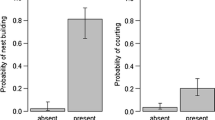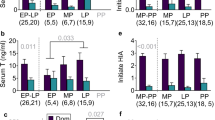Abstract
In many cooperatively breeding species, dominant females suppress reproduction in subordinates. Although it is commonly assumed that aggression from dominant females plays a role in reproductive suppression, little is known about the distribution of aggressive interactions. Here, we investigate the distribution of aggressive and submissive interactions among female meerkats (Suricata suricatta). In this species, dominant females produce more than 80% of the litters, but older subordinates occasionally breed. Dominant females commonly kill the pups of subordinates and usually evict older female subordinates from the group 1–3 weeks before the birth of the dominant female's litter. The aggression frequency of the dominant female toward subordinates and the submission frequency that each subordinate female showed to the dominant female increased as the age of the subordinate female increased and as the birth of the dominant female's pups approached. Moreover, as birth approached, both of these behaviors intensified more quickly between the dominant female and older subordinates than between the dominant female and younger subordinates. The aggression frequency of the dominant female toward each subordinate female predicted whether that subordinate female was evicted from the group; the submission frequency by each subordinate female predicted the timing of their eviction during the pregnancy period of the dominant female. These results support the idea that conflict between dominant and subordinate females increases with the age of subordinates and, since older subordinate females are most likely to reproduce, suggest that dominant females may less easily control reproductive attempts by older subordinate females.


Similar content being viewed by others
References
Altmann J (1974) Observational study of behavior: sampling methods. Behaviour 49:227–265
Bennett NC, Faulkes CG (2000) African mole-rats: ecology and eusociality. Cambridge University Press, New York
Burland TM, Bennett NC, Jarvis JUM, Faulkes CG (2004) Colony structure and parentage in wild colonies of cooperatively breeding Damaraland mole-rats suggest incest avoidance alone may not maintain reproductive skew. Mol Ecol 13:2371–2379
Cant MA (1998) A model for the evolution of reproductive skew without reproductive suppression. Anim Behav 55:163–169
Carlson AA, Young AJ, Russell AF, Bennett NC, McNeilly AS, Clutton-Brock T (2004) Hormonal correlates of dominance in meerkats (Suricata suricatta). Horm Behav 46:141–150
Clutton-Brock TH (1998) Reproductive skew, concessions and limited control. TREE 13:288–292
Clutton-Brock TH, Brotherton PNM, Smith R, McIlrath GM, Kansky R, Gaynor D, O'Riain JM, Skinner JD (1998) Infanticide and expulsion of females in a cooperative mammal. Proc R Soc Lond B Biol Sci 265:2291–2295
Clutton-Brock TH, MacColl ADC, Chadwick P, Gaynor D, Kansky R, Skinner JD (1999a) Reproduction and survival of suricates (Suricata suricatta) in the southern Kalahari. Afr J Ecol 77:69–80
Clutton-Brock TH, Gaynor D, McIlrath GM, MacColl ADC, Kansky R, Chadwick P, Manser M, Brotherton PNM, Skinner JD (1999b) Predation, group size and mortality in a cooperative mongoose, Suricata suricatta. J Anim Ecol 68:672–683
Clutton-Brock TH, Brotherton PNM, Russell AF, O'Riain MJ, Gaynor D, Kansky R, Griffin A, Manser M, Sharpe L, McIlrath GM, Small T, Moss A, Monfort S (2001) Cooperation, conflict and concession in meerkat groups. Science 291:478–481
Clutton-Brock TH, Russell AF, Sharpe LL, Young AJ, Balmforth Z, McIlrath GM (2002) Evolution and development of sex differences in cooperative behavior in meerkats. Science 297:253–256
Cooney R, Bennett NC (2000) Inbreeding avoidance and reproductive skew in a cooperative mammal. Proc R Soc Lond B Biol Sci 267:801–806
Crawley MJ (2002) Statistical computing: an introduction to data analysis using S-Plus. Wiley, Chichester
Creel SR, Creel NM (1991) Energetics, reproductive suppression and obligate communal breeding in carnivores. Behav Ecol Sociobiol 28:263–270
Creel SR, Creel NM (2002) The African wild dog: behavior, ecology, and conservation. Princeton University Press, Princeton
Creel S, Macdonald DW (1995) Sociality, group size, and reproductive suppression among carnivores. Adv Study Behav 24:203–257
Creel SR, Waser PM (1991) Failures of reproductive suppression in dwarf mongooses (Helogale parvula): accident or adaptation? Behav Ecol 2:7–15
Creel SR, Waser PM (1997) Variation in reproductive suppression among dwarf mongooses: interplay between mechanisms and evolution. In: Solomon N, French JA (eds) Cooperative breeding in mammals. Cambridge University Press, Cambridge, pp 150–170
Creel S, Creel NM, Wildt DE, Monfort SL (1992) Behavioral and endocrine mechanisms of reproductive suppression in Serengeti dwarf mongooses. Anim Behav 43:231–245
Doolan SP, MacDonald DW (1996) Dispersal and extra-territorial prospecting by slender-tailed meerkats (Suricata suricatta) in the south-western Kalahari. J Zool 240:59–73
Doolan SP, MacDonald DW (1997a) Band structure and failure of reproductive suppression in a cooperative breeding carnivore, the slender-tailed meerkats (Suricata suricatta) in the south-western Kalahari. Behaviour 134:827–848
Doolan SP, MacDonald DW (1997b) Breeding and juvenile survival among slender-tailed meerkats (Suricata suricatta) in the south-western Kalahari: ecological and social influences. J Zool 242:309–327
Faulkes CG, Abbott DH (1997) Proximate mechanisms regulating a reproductive dictatorship: a single dominant female controls male and female reproduction in colonies of naked mole-rats. In: Solomon N, French JA (eds) Cooperative breeding in mammals. Cambridge University Press, Cambridge, pp 268–301
French JA (1997) Proximate regulation of singular breeding in callitrichid primates. In: Solomon N, French JA (eds) Cooperative breeding in mammals. Cambridge University Press, Cambridge, pp 34–75
Griffin AS, Pemberton JM, Brotherton PNM, McIlrath GM, Gaynor D, Kansky R, Clutton-Brock TH (2004) A genetic analysis of breeding success in the cooperative meerkat (Suricata suricatta). Behav Ecol 14:472–480
Keller L, Reeve HK (1994) Partitioning of reproduction in animal societies. TREE 9:98–102
Koenig WD, Dickinson JL (2004) Ecology and evolution of cooperative breeding in birds. Cambridge University Press, Cambridge
Koenig WD, Haydock J (2004) Incest and incest avoidance. In: Koenig WD, Haydock J (eds) Ecology and evolution of cooperative breeding in birds. Cambridge University Press, Cambridge, pp 142–156
Lazaro-Perea C, Castro CSS, Harrison R, Araujo A, Arruda MF, Snowdon CT (2000) Behavioral and demographic changes following the loss of the breeding female in cooperatively breeding marmosets. Behav Ecol Sociobiol 48:137–146
Moehlman PD, Hofer H (1997) Cooperative breeding, reproductive suppression, and body mass in canids. In: Solomon N, French JA (eds) Cooperative breeding in mammals. Cambridge University Press, Cambridge, pp 76–128
O'Riain MJ, Bennett NC, Brotherton PNM, McIlrath GM, Clutton-Brock TH (2000) Reproductive suppression and inbreeding avoidance in wild populations of cooperatively breeding meerkats (Suricata suricatta). Behav Ecol Sociobiol 48:471–477
Rasa OAR (1987) The dwarf mongoose: a study of behaviour and social structure in relation to ecology in a small, social carnivore. Adv Study Behav 17:121–163
Reeve HK, Emlen ST, Keller L (1998) Reproductive sharing in animal societies: reproductive incentives or incomplete control by dominant breeders? Behav Ecol 9:267–278
Russell AF (2004) Mammals: comparisons and contrasts. In: Koenig WD, Haydock J (eds) Ecology and evolution of cooperative breeding in birds. Cambridge University Press, Cambridge, pp 210–227
Russell AF, Clutton-Brock TH, Brotherton PNM, Sharpe LL, McIlrath GM, Dalerum FD, Cameron EZ, Barnard JA (2002) Factors affecting pup growth and survival in cooperatively breeding meerkats Suricata suricatta. J Anim Ecol 71:700–709
Russell AF, Brotherton PNM, McIlrath GM, Sharpe LL, Clutton-Brock TH (2003) Breeding success in cooperative meerkats: effects of helper number and maternal state. Behav Ecol 14:486–492
Schaffner CM, Caine NG (2000) Peacefulness in cooperatively breeding primates. In: Aureli F, de Waal FBM (eds) Natural conflict resolution. California University Press, Berkeley, CA, pp 155–169
Schall R (1991) Estimation in generalized linear models with random effects. Biometrika 78:719–727
Schoech SJ, Reynolds SJ, Boughton RK (2004) Endocrinology. In: Koenig WD, Haydock J (eds) Ecology and evolution of cooperative breeding in birds. Cambridge University Press, Cambridge, pp 128–141
Solomon NG, French JA (1997) Cooperative breeding in mammals. Cambridge University Press, Cambridge
Stacey PB, Koenig WD (1990) Cooperative breeding in birds: long-term studies of ecology and behavior. Cambridge University Press, Cambridge
Stankowich T, Sherman PW (2002) Pup shoving by adult naked mole-rats. Ethology 108:975–992
van der Westhuizen LA, Bennett NC, Jarvis JUM (2002) Behavioural interactions, basal plasma luteinizing hormone concentrations and the differential pituitary responsiveness to exogenous gonadotrophin-releasing hormone in entire colonies of the naked mole-rat (Heterocephalus glaber). J Zool 256:25–33
Vehrencamp SL (1983a) A model for the evolution of despotic versus egalitarian societies. Anim Behav 31:667–682
Vehrencamp SL (1983b) Optimal skew in cooperative societies. Am Zool 23:327–355
Young AJ (2003) Subordinate tactics in cooperative meerkats: helping, breeding and dispersal. Ph.D. thesis, Cambridge University
Zack S, Rabenold KN (1989) Assessment, age and proximity in dispersal contests among cooperative wrens: field experiments. Anim Behav 38:235–247
Acknowledgements
We would like to thank English, S., Moyes, K., Fry, Z., Ballantyne, F., Baker, M., Flower, T., King, A., Ross-Gillespie, A., Walker, C., Skinner, K., Hill, M., Golabek, K., Johnson, H., Minting, P., Thornton, A., Turbe, A., Spong, G., van der Vyver, M., Scantlebury, M., Ridley, M., Raihani, N., and Hollen, L., for support over the course of this study. We especially thank Jordan, N., Sharpe, L.L., Russell, A., Hodge, S., Young, A., Manica, A., and Matsumura, S., for supporting for this study and the discussions. Hodge, S., and Young, A., gave many useful comments on the manuscript. This study was supported by JSPS Research Fellowships.
Author information
Authors and Affiliations
Corresponding author
Additional information
Communicated by S. Alberts
Rights and permissions
About this article
Cite this article
Kutsukake, N., Clutton-Brock, T.H. Aggression and submission reflect reproductive conflict between females in cooperatively breeding meerkats Suricata suricatta . Behav Ecol Sociobiol 59, 541–548 (2006). https://doi.org/10.1007/s00265-005-0079-7
Received:
Revised:
Accepted:
Published:
Issue Date:
DOI: https://doi.org/10.1007/s00265-005-0079-7




